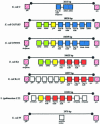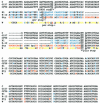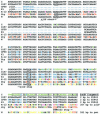Cassette-like variation of restriction enzyme genes in Escherichia coli C and relatives
- PMID: 14744977
- PMCID: PMC373321
- DOI: 10.1093/nar/gkh194
Cassette-like variation of restriction enzyme genes in Escherichia coli C and relatives
Abstract
A surprising result of comparative bacterial genomics has been the large amount of DNA found to be present in one strain but not in another of the same species. We examine in detail one location where gene content varies extensively, the restriction cluster in Escherichia coli. This region is designated the Immigration Control Region (ICR) for the density and variability of restriction functions found there. To better define the boundaries of this variable locus, we determined the sequence of the region from a restrictionless strain, E.coli C. Here we compare the 13.7 kb E.coli C sequence spanning the site of the ICR with corresponding sequences from five E.coli strains and Salmonella typhimurium LT2. To discuss this variation, we adopt the term 'framework' to refer to genes that are stable components of genomes within related lineages, while 'migratory' genes are transient inhabitants of the genome. Strikingly, seven different migratory DNA segments, encoding different sets of genes and gene fragments, alternatively occupy a single well-defined location in the seven strains examined. The flanking framework genes, yjiS and yjiA, display approximately normal patterns of conservation. The patterns observed are consistent with the action of a site-specific recombinase. Since no nearby gene codes for a likely recombinase of known families, such a recombinase must be of a new family or unlinked.
Figures





Similar articles
-
Cloning and nucleotide sequence of the Salmonella typhimurium LT2 metF gene and its homology with the corresponding sequence of Escherichia coli.Mol Gen Genet. 1988 May;212(2):246-51. doi: 10.1007/BF00334692. Mol Gen Genet. 1988. PMID: 2841568
-
Distribution and diversity of hsd genes in Escherichia coli and other enteric bacteria.J Bacteriol. 1988 Apr;170(4):1775-82. doi: 10.1128/jb.170.4.1775-1782.1988. J Bacteriol. 1988. PMID: 2832380 Free PMC article.
-
Nucleotide sequences of the genes regulating O-polysaccharide antigen chain length (rol) from Escherichia coli and Salmonella typhimurium: protein homology and functional complementation.J Bacteriol. 1992 Aug;174(16):5228-36. doi: 10.1128/jb.174.16.5228-5236.1992. J Bacteriol. 1992. PMID: 1379582 Free PMC article.
-
Cloning and nucleotide sequence of the Salmonella typhimurium LT2 gnd gene and its homology with the corresponding sequence of Escherichia coli K12.Mol Gen Genet. 1989 May;217(1):182-4. doi: 10.1007/BF00330960. Mol Gen Genet. 1989. PMID: 2671649
-
Determinants of DNA sequence divergence between Escherichia coli and Salmonella typhimurium: codon usage, map position, and concerted evolution.J Mol Evol. 1991 Jul;33(1):23-33. doi: 10.1007/BF02100192. J Mol Evol. 1991. PMID: 1909371 Review.
Cited by
-
Reassembling a cannon in the DNA defense arsenal: Genetics of StySA, a BREX phage exclusion system in Salmonella lab strains.PLoS Genet. 2022 Apr 4;18(4):e1009943. doi: 10.1371/journal.pgen.1009943. eCollection 2022 Apr. PLoS Genet. 2022. PMID: 35377874 Free PMC article.
-
Improving the efficiency of transposon mutagenesis in Salmonella enteritidis by overcoming host-restriction barriers.Mol Biotechnol. 2014 Nov;56(11):1004-10. doi: 10.1007/s12033-014-9779-4. Mol Biotechnol. 2014. PMID: 24973023
-
The genome sequence of E. coli W (ATCC 9637): comparative genome analysis and an improved genome-scale reconstruction of E. coli.BMC Genomics. 2011 Jan 6;12:9. doi: 10.1186/1471-2164-12-9. BMC Genomics. 2011. PMID: 21208457 Free PMC article.
-
Rpn (YhgA-Like) Proteins of Escherichia coli K-12 and Their Contribution to RecA-Independent Horizontal Transfer.J Bacteriol. 2017 Mar 14;199(7):e00787-16. doi: 10.1128/JB.00787-16. Print 2017 Apr 1. J Bacteriol. 2017. PMID: 28096446 Free PMC article.
-
Identification and characterization of the WYL BrxR protein and its gene as separable regulatory elements of a BREX phage restriction system.Nucleic Acids Res. 2022 May 20;50(9):5171-5190. doi: 10.1093/nar/gkac311. Nucleic Acids Res. 2022. PMID: 35511079 Free PMC article.
References
-
- Raleigh E.A. (1992) Organization and function of the mcrBC genes of E.coli K-12. Mol. Microbiol., 6, 1079–1086. - PubMed
-
- Arber W. and Wauters-Willems,D. (1970) Host specificity of DNA produced by Escherichia coli. XII. The two restriction and modification systems of strain 15T-. Mol. Gen. Genet., 108, 203–217. - PubMed
MeSH terms
Substances
Associated data
- Actions
LinkOut - more resources
Full Text Sources
Molecular Biology Databases

